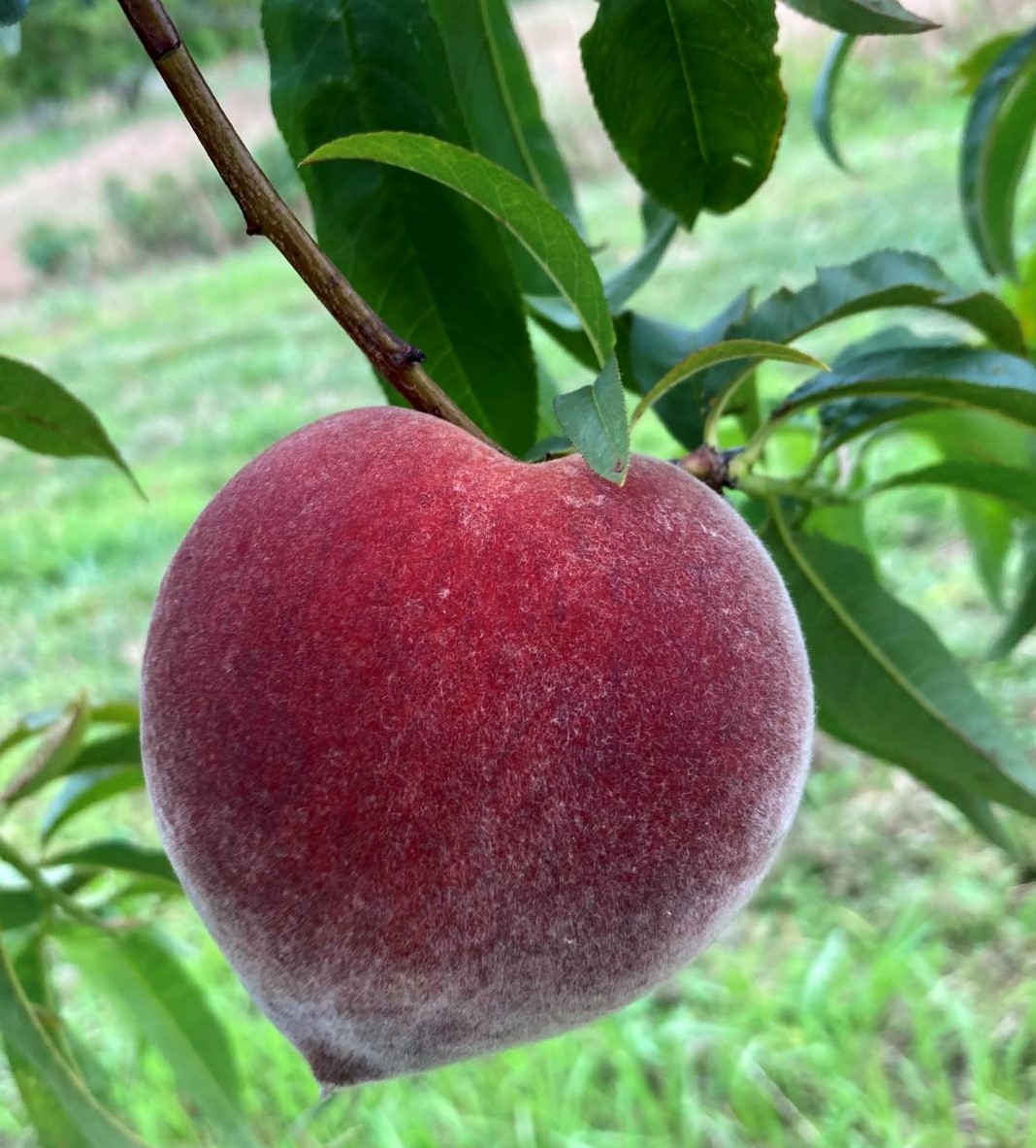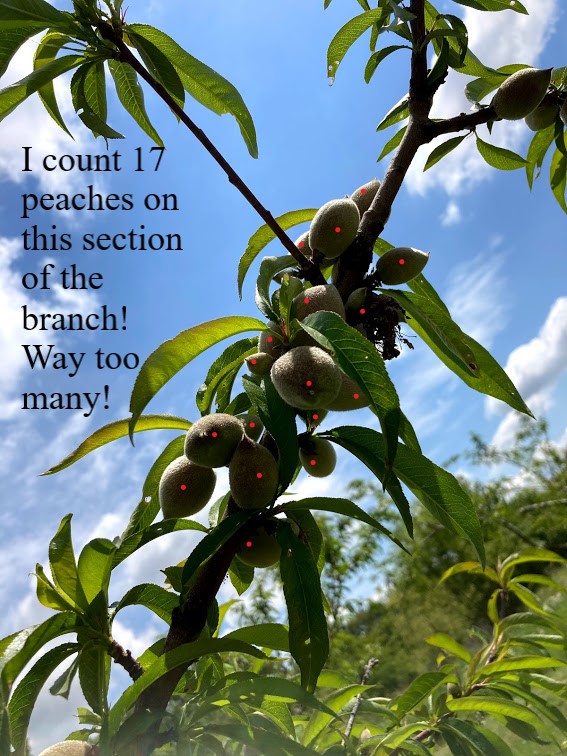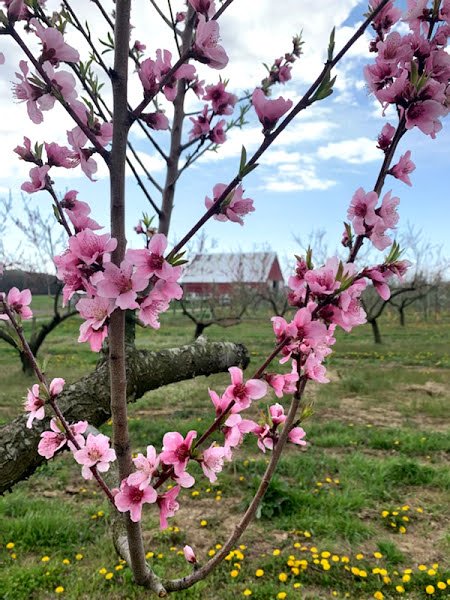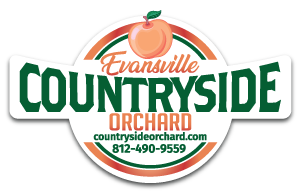It's PEACH Season

Jul 4, 2021

It’s PEACH SEASON!!! We made it! It’s what we’ve been working toward the entire off-season. Although we still have some “farm chores” that need to be completed, our days are now centered around checking trees and picking the fruit that is ripe. Let me use a sports analogy. It is like we have been practicing and practicing, and now it is finally game time.
Our harvest season is fast-paced and spans from late May (strawberries/cherries) to late October (apples). While I am always ready for a break and enjoy the slower pace of winter, I get antsy sometime in April. I’m tired of the physical labor and quiet. I’m ready for the hustle and bustle of employees and customers and markets.
So, here we are. It’s July and the rhythm of summer is setting in. We have a good team (albeit, small) working with us this year, and many of them are new to us. It has been fun getting to know these employees and teaching them about the work of growing fruit. Up to this point, we have done lots of tree care, which is very important, but not too exciting. But now we are picking! It’s like we’re finally in the game.
If you have visited us at the farm or at the area markets, I hope you can tell that we missed you! The onset of a new season means we get the opportunity to see you and catch up with you. It’s so fun for us to recognize friends from past seasons and also to make new acquaintances. If you are new to our sphere, welcome! Feel free to chat us up and ask questions.
We’ll see you soon at the orchard (M-F 9am-4pm/Weekends 9am-1pm) or at a market: Wednesdays - Market on Main, 9am-1:30pm; Saturdays - Franklin Street Bazaar, 9am-1pm and Historic Newburgh Farmer’s Market, 8am-noon.
One Race Leads to the Next

May 26, 2021

Last month we highlighted the frost gamble fruit growers take each spring. The results are in, and we rolled Boxcars! The early April frost didn’t wipe out the crop. We happily report the peaches are plentiful!
We are relieved and grateful, but also very, very tired. Peach trees require A LOT of care and attention to produce their delicious and juicy fruit. This is hands-on, back-breaking work. We don’t have a magic potion or robots to get the job done. It’s up to us (currently a team of three) to manually prune and thin each tree -- every one of the over 1,000 we have. Smaller trees are easier than large ones which may require working from a wagon or ladder to reach high limbs. This tree maintenance and crop load management takes at least 15 minutes per tree…1,000 times…yeah, it’s a lot!
Pruning is the annual process of removing some branches to maintain the tree architecture and tree health. We prune to shape the tree with an open center (think of a funnel) allowing sunlight to reach maximum leaves and fruit on the trees. Additionally, limbs that are too long may be shortened or removed and broken/dead branches must be taken out. As a result, we have piles and piles of cut branches around the orchard. Thus, an upcoming job for us will be chipping these limbs and using the wood chips around the farm.
Believe it or not, some years there are too many peaches on the trees (this is one of those years)! It’s a great situation to be in, but it does require more work of us. We must manage the crop load on our peach trees by thinning. Thinning is removing excess peaches. Yes, you read that right. We must take some fruit off the trees in order to grow peaches of good size and flavor. In fact, years like this where there is a heavy fruit set require us to take off up to 90% of the peaches. The reason is twofold: (1) To allow space for the remaining fruit to grow large. It’s sort of like clearing the middle seat on an airplane, allowing for elbow room; (2) To ensure a tree’s energy and nutrient supply is divided across less fruit. Think about it…when there are less “mouths to feed”, everyone gets more food. Additionally, limbs that are loaded with too many peaches are more prone to breaking. Failing to do this important task would result in a harvest of lots and lots of tiny, tasteless peaches and many broken branches, and nobody wants that.
So here we are, nearing the end of May, and we have almost completed this race – a qualifier of sorts. This work must be done before moving on to the main event – HARVEST. One race leads to the next, and the next, and the next….
I'm Not a Gambler, am I?

Apr 8, 2021
I’m not a gambler. Not in any way, shape, or form. I like to plan, to be in control, and I love schedules. (Sidenote: I’m a teacher by training. Need I say more?) But in my current reality, uncertainty is ever present. We are now in the midst of the “annual gamble”. It’s springtime, in Southern Indiana, where temperatures may fluctuate from freezing, to balmy, to mild, and back again to freezing. It’s this way every year. Hoping that the trees remain dormant long enough to withstand the inevitable spring frost events.
It happened last year. Freeze events the second week of April and then again on May 8! Yes, that’s right, we had a frost event in May last year! It was crazy. Peach and nectarine harvests were around 50%, and our sweet cherry crop was a total loss.
So, here we are in the first week of April. Our peach and nectarine trees started blooming about two weeks ago. Don’t you know it, on April 1 we had temperatures in the mid to low 20s. Oof…that is a nail biter! The experts say that these low temps could kill between 10% and 90% of the blooms. They also say that only about 10% of the blossoms are needed to produce a full crop. (Biological principle of overproduction at work). Whatever…it always makes me nervous.
We know that some trees are hardier than others and that the location/elevation of the plantings also impact the exposure. So, we walk the orchard, examining and picking apart blossoms to determine viability. The report so far? We can tell that a section of nectarines (those on the west side without any protection) appear to have been hard hit. Our sweet cherry crop also is questionable. We will have peaches – how many is yet to be known. Apple trees are just now blooming out, and they look really good at the moment.
Just like a roll of the dice, a spin of the wheel, a turn of a card, I’m not in control of the outcome. Springtime in Southern Indiana, it’s always a gamble.
